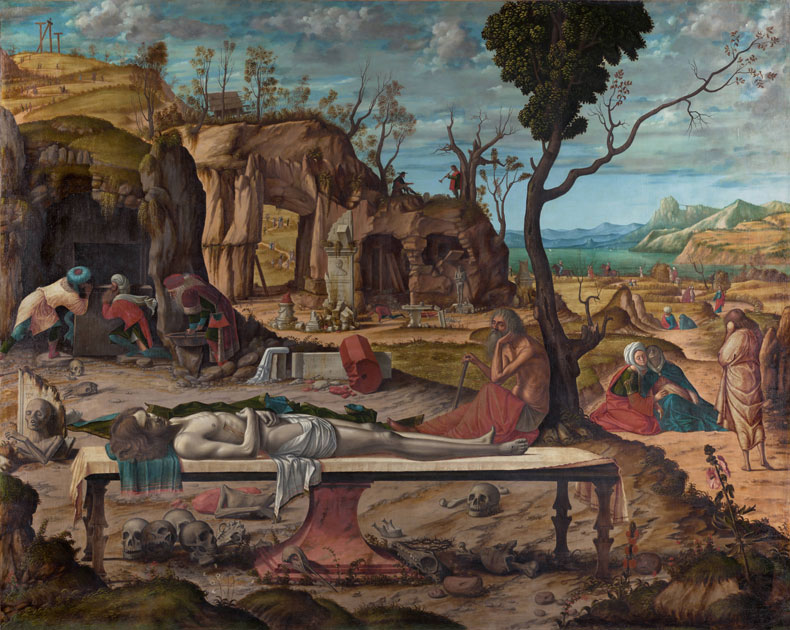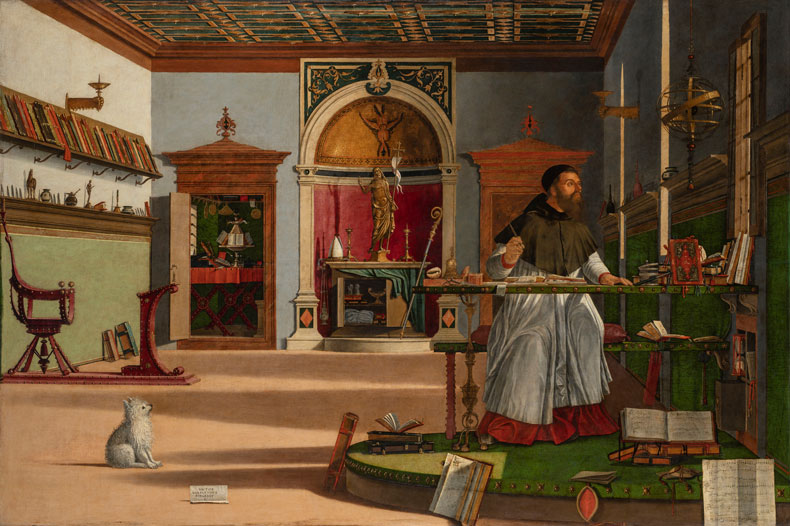From the December 2025 issue of Apollo. Preview and subscribe here.
Directions are no use: you’ll just have to discover it somehow. My technique is to keep following the yellow signs and you’ll stumble across it through a kind of managed accident. You’ll pass a grocery selling novelty pasta, a wedding photographer’s studio, a pharmacy with its flashing green cross. And there it suddenly is: a marble-fronted building, small in relation to its neighbours, lodged at the foot of a bridge. And you’re in luck: it’s open. The reason why this location remains so hard to find is that you never fully see it. Wedged between adjacent apartment blocks, its facade is disrupted by the jutting poles used to moor boats, or the tourist groups heading past it, heading elsewhere. Yet it’s appropriate that there’s no unblocked vista of the Scuola di San Giorgio degli Schiavoni. Entangled as it is within the fabric of Venice, it’s the ideal venue to get close to the poet of the city’s urban life, Vittore Carpaccio, who died five centuries ago this year or next, depending on which of two possible dates you favour.
Henry James, who thought Carpaccio ‘sailed nearer to perfection’ than any of his now more celebrated contemporaries of the Venetian Renaissance, found the Schiavoni ‘small and incommodious, the pictures are out of sight and ill-lighted, the custodian is rapacious, the visitors are mutually intolerable, but the shabby little chapel is the palace of art.’ The obvious response to this is: what visitors? James was writing at a time in which Carpaccio’s star was in the ascendant, the artist having been gradually rediscovered in the second half of the 19th century, first by artists such as Edgar Degas and Edward Burne-Jones, then by John Ruskin, whose ‘generous lamp’ illuminated his work for Victorian audiences. You can imagine James huffily elbowing the crowds of fellow gawpers out of his line of sight. Yet today the place is usually empty, the orderly worlds of the artist’s paintings seeming more distant now than they must have in James’s time. Carpaccio’s no Caravaggio: there’s no colourful biography to pull viewers in and his tidy scenarios can feel naive, or alien, to contemporary audiences. But that’s if you’re not really looking. Carpaccio, like Bruegel the Elder, is nothing if not generous to the wandering eye.

Like all of Carpaccio’s works, the paintings in the Schiavoni have ostensible subjects (Saint George killing the dragon, Saint Jerome bringing a lion home to his monastery, with hilarious consequences) but never seem too beholden to telling the story straight. His images are somehow digressive, long-winded. In his painting of Saint Augustine in his study (c. 1502) – which James thought united ‘the most masterly finish with a kind of universal largeness of feeling’ – the saint hesitates while writing a letter, the sunlight on his face standing for the sudden knowledge of the death of his correspondent, Saint Jerome. With Augustine distracted, we’re let loose to rummage through his study, to lose ourselves in his collection of trinkets and sculptures, the astrolabe and armillary sphere and his literary lazy Susan.
The same goes for the artist’s great cycle of paintings on the theme of Saint Ursula, now housed in the Accademia Gallery in Venice. Not even Carpaccio seems especially gripped by the Golden Legend narrative he’s apparently illustrating. What’s more interesting is what happens when you diverge from the main current of the story: duck into an alley between two fantastical buildings, take a snaking path up a hillside or squeeze through a jostling crowd of onlookers. The trick is to treat his paintings like Venice itself: to rove unhurriedly through his fictive streets and squares, to indulge in the pleasures of getting lost, allowing meanings to emerge by accident. It’s a dreamily distracted quality shared by many of Carpaccio’s characters. In the canvas titled Arrival of the Ambassadors, almost every face is looking listlessly away from the main event, the arrangement of the marriage of princess Ursula, daughter of the king of Brittany, to the pagan prince Etherius. And in the adjacent scene, in which Ursula is enumerating on slender fingers all of the conditions of their marriage, her father the king looks as though he’d rather be anywhere else but there.

Carpaccio’s recently restored painting The Preparation of Christ’s Tomb (1505/20), now on view in a small exhibition at the Gemäldegalerie, Berlin, is the most digressive of all. The scene takes place in a temporal grey zone between the death and burial of Christ. He is laid out on a flat table in the foreground, with the event of the painting’s title shunted towards the left and, as is the artist’s tendency, it’s all extrapolation from there. The hollow forms of the human and animal skulls that litter the barren floor are picked up in the skull-like shape of the hillside in the middle distance, its interior scooped out to accommodate tombs. A pattern of thin, bent arms repeats like a dance move from Christ’s body to Job’s, transplanted into the scene from the Old Testament, to the mummified corpses dispersed across the landscape. Though close to the work of his contemporaries, such as Andrea Mantegna and Giovanni Bellini, the work’s eerie doubling of related shapes and resistance to narrative closure seem to anticipate the work of Giorgio de Chirico, even Dalí. And although the painting can’t be securely dated, there’s no missing its resonance with a near-contemporary image, Dürer’s Melencolia I (1514). Both works bring together the head-in-hand motif of melancholy with mysterious geometric forms, in Carpaccio’s case a broken column, towards which Job gazes uncomprehendingly. We might respond to the painting itself in a similar way.
The Preparation joins a suite of Carpaccio works, including two of the Schiavoni paintings and the complete Ursula cycle, that have been restored in recent years. Yet the restoration of this painting has done nothing to resolve its mysteries; it has, if anything, made them more compelling. Removing layers of yellowed varnish and grime has restored to focus the artist’s knife-sharp handling of the textures of stone, fabric and vegetation. The pattern of orangey-red areas, which draw the eye from the reddish stone of the base of the table on which Christ is laid all the way to the crimson tabard of the musician in the distance, is warmer and brighter now. This enhanced visibility makes clearer what it was Henry James saw in Carpaccio and what we might too: visions of the ordinary world intensified through attention. The way the world might look through the eyes of someone restored to life.

‘Tribute to Vittore Carpaccio’ is at the Gemäldegalerie, Berlin, until 6 April 2026.
From the December 2025 issue of Apollo. Preview and subscribe here.